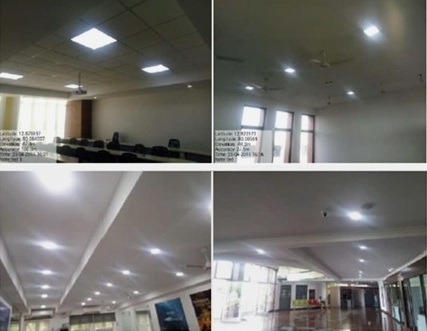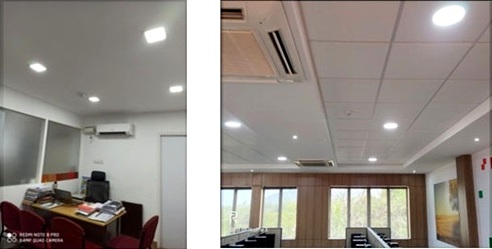Crescent Sustainability Initiatives
Affordable and Clean Energy (SDG 7)
Strategic Energy Reduction Framework – Institutional Commitment to Sustainable Practices
B.S. Abdur Rahman Crescent Institute of Science and Technology (BSACIST) has developed a comprehensive energy efficiency plan that goes beyond traditional conservation methods. The institute’s approach is meticulously documented, emphasizing sustainability as a core principle in building construction, renovation, and administration. By pursuing multiple building rating systems such as EDGE, IGBC, and LEED, BSACIST ensures that both existing and new structures meet rigorous energy efficiency standards. The plan encompasses a holistic strategy that includes sustainable design features, efficient waste management, and innovative technologies to minimize energy consumption across the campus.
Establishing a Robust Energy Efficiency Plan for Sustainable Savings
The energy audit conducted at B.S. Abdur Rahman Crescent Institute of Science and Technology has laid a robust foundation for an energy efficiency plan aimed at significantly reducing overall energy consumption on campus. The audit identified key areas where energy savings can be achieved, amounting to an annual savings potential of 487,014 kWh, which translates to a cost saving of approximately Rs. 4,011,685. The proposed investment for implementing various energy conservation measures (ECMs) is estimated at Rs. 15,950,000, with an average payback period of 48 months. This structured approach not only emphasizes immediate cost savings but also aligns with the institution’s commitment to sustainability and renewable energy.
Technological Innovations and Infrastructure Upgrades
The energy efficiency plan incorporates cutting-edge technologies and strategic infrastructure improvements. Key initiatives include the installation of 650 kWp solar photovoltaic power plants, which now constitute 18% of total electricity consumption, and solar water heating systems with a 39,500-liter capacity. The institute has systematically replaced old air conditioning units with BEE 5-star rated units, with 117 units installed featuring energy-efficient specifications. Advanced technologies like variable frequency drives in pumps, cooling towers, and air handling units allow for real-time energy consumption regulation based on actual occupancy. Additionally, the use of AAC/Aerocon blocks, high-performance glass, and energy-efficient roof configurations helps minimize heat ingress and reduce cooling demands.
Comprehensive Monitoring and Adaptive Strategies
BSACIST’s energy efficiency approach is characterized by continuous monitoring and adaptive strategies. Annual energy consumption audits are conducted to identify and implement energy-saving measures. The institute has implemented detailed metering systems that enable real-time data collection and resource management. Innovative solutions such as motion sensor lights in computer science labs, staff cabins, and toilets, along with natural ventilation strategies in classrooms and staff areas, contribute to significant energy savings. The use of low VOC materials, bio-degradable cleaning chemicals, and high-reflective roofing materials further enhances the institution’s comprehensive approach to energy conservation.
Research and Collaborative Sustainability Initiatives
The energy efficiency plan extends beyond technological implementations to include research and collaborative initiatives. BSACIST supports R&D activities focused on energy-efficient renovation and building technologies. The institute actively seeks national and international collaborations to facilitate access to green building technologies. Student volunteering programs and technology transfer initiatives play a crucial role in promoting energy-efficient practices among local communities, governments, and NGOs. The ultimate vision is to transform the campus into a net-zero energy environment that not only minimizes its carbon footprint but also serves as a model for sustainable institutional development.
Future-Oriented Sustainability Vision
BSACIST’s energy efficiency strategy represents a forward-thinking approach to environmental stewardship. By integrating advanced technologies, sustainable design principles, and collaborative research initiatives, the institute has created a holistic framework for reducing energy consumption. The comprehensive plan not only addresses immediate energy conservation needs but also sets a benchmark for sustainable practices in higher education. As BSACIST continues to invest in these innovative approaches, it reinforces its commitment to creating an environmentally responsible campus that benefits current and future generations.
ENERGY EFFICIENT APPLIANCES @ BSACIST
Enhancing Energy Efficiency with Smart Door Locks

Figure VII (2.4)-1 : Smart Door Locks – KBA Men’s Hostel
B.S. Abdur Rahman Crescent Institute of Science and Technology (BSACIST) has implemented energy-sparing solutions through the installation of smart door locks in its facilities, such as the KBA Men’s Hostel. These state-of-the-art locking systems not only enhance security but also contribute to energy efficiency by controlling access to communal spaces based on real-time occupancy. The integration of smart technology allows for automatic locking and unlocking, reducing the frequency of door handling and minimizing energy loss associated with heating or cooling open areas. By ensuring that doors remain closed when not in use, these smart locks help maintain optimal indoor climates, furthering BSACIST’s commitment to sustainable practices. This innovative approach reflects the institution’s dedication to creating a more energy-conscious campus environment while prioritizing the safety and comfort of its residents.
Sustainable Cooling with Evaporative Air Cooling Systems

Figure VII (2.4)-2 : Evaporative Air Cooling Systems
B.S. Abdur Rahman Crescent Institute of Science and Technology (BSACIST) has adopted evaporative air cooling systems as an energy-efficient solution for maintaining indoor comfort across its campus facilities. This environmentally friendly cooling method leverages the natural process of evaporation to cool the air, using significantly less energy than conventional air conditioning systems. By drawing in hot, dry air and passing it over water-saturated pads, the system effectively reduces the air temperature, creating a comfortable atmosphere for students and staff. This not only lowers energy consumption but also minimizes the campus’s overall carbon footprint. The strategic placement of these systems ensures optimal air circulation while maintaining efficiency, reinforcing BSACIST’s commitment to sustainable practices and innovative solutions for a greener future.
Energy-Efficient Lighting with LED Fixtures
B.S. Abdur Rahman Crescent Institute of Science and Technology (BSACIST) has embraced energy efficiency through the extensive use of LED lighting fixtures throughout its campus. These modern lighting solutions, showcased in various spaces—including classrooms, conference rooms, and hallways—offer significant improvements over traditional lighting systems. LED fixtures consume considerably less energy while providing superior illumination quality, resulting in lower electricity bills and reduced environmental impact. Additionally, the longevity of LED bulbs minimizes the need for frequent replacements, further enhancing cost-effectiveness and sustainability. By integrating LED lighting across the campus, BSACIST not only fosters a bright, conducive learning environment but also reinforces its commitment to sustainable practices that benefit both the institution and its community.

Figure VII (2.4)-3 : The image features various indoor spaces within a facility optimized for energy efficiency through modern lighting solutions.
Efficient Lighting through Passive Infrared Motion Sensor Technology
B.S. Abdur Rahman Crescent Institute of Science and Technology (BSACIST) has integrated Passive Infrared (PIR) Motion Sensor lights into various spaces, including staff cabins and computer labs, to enhance energy efficiency while ensuring optimal illumination. These innovative lighting solutions automatically detect occupancy, turning on when individuals enter a room and switching off when the space is unoccupied. This not only reduces energy consumption significantly but also prolongs the lifespan of the lighting fixtures. In the staff cabins, the subtle and efficient lighting creates a conducive working environment, while in the computer labs, it supports focused study sessions without the constant need for manual control. By implementing PIR motion sensor lights, BSACIST is not only enhancing the functionality of its spaces but also reaffirming its commitment to sustainable practices that minimize energy waste.

Figure VII (2.4)-4 : Passive Infrared Motion Sensor Lights installed – Staff Cabin & Computer Lab
Reimagining Thermal Comfort through Natural Ventilation
B.S. Abdur Rahman Crescent Institute of Science and Technology (BSACIST) has pioneered a revolutionary approach to energy conservation by prioritizing natural ventilation over traditional air conditioning systems. This strategic initiative focuses on mechanical air circulation combined with natural airflow, significantly reducing energy consumption in classrooms and staff cabins. By leveraging architectural design and strategic ventilation techniques, the institute has created an environment that not only minimizes electricity usage but also enhances indoor air quality.

Figure VII (2.4)-4 : Mechanical Air Circulation is Used with Natural Ventilation
POLICY FOR ENERGY-EFFICIENT RENOVATION AND BUILDING
Issue: 04; Revised on 2023
| Policy Created on | July 2009 |
| 1st Revision amended on | IQAC Meeting held on 27th October 2017 |
| 2nd Revision amended on | IQAC Meeting held on 31st March 2021 |
| 3rd Revision amended on | IQAC Meeting held on 16th June 2023 |
Responsible Executive : Director (IQAC)
Responsible Office : Internal Quality Assurance Cell, Estate Office, and SDG Cell
Contacts : Registrar, Director (IQAC)
The B.S. Abdur Rahman Crescent Institute of Science and Technology is committed to ensuring that all renovations and new constructions on campus adhere to stringent energy efficiency standards. This policy aims to:
- Ensure universal access to affordable, reliable, modern energy services.
- Increase substantially the share of renewable energy in the global energy mix.
- Double the global rate of improvement in energy efficiency
- Enhance international cooperation to facilitate access to clean energy research and technology.
- Expand infrastructure and upgrade technology to supply modern and sustainable energy services, particularly in developing countries.
7.2 REASON FOR THIS POLICY
This policy is established to promote energy-efficient practices in renovating existing infrastructures and constructing new buildings. By adhering to energy efficiency standards, the Institute aims to reduce greenhouse gas emissions, lower operational costs, and contribute to the global efforts to combat climate change, which aligns with SDG 7 – Affordable and Clean Energy.
7.3 RESPONSIBILITIES
7.3.1 Policy Principles
The Institute shall implement the following principles to ensure compliance with energy efficiency standards:
- All renovations and new constructions must achieve recognised building rating systems such as EDGE, IGBC, and LEED.
- Sustainable design features, including using renewable energy sources, shall be integrated into all projects.
- An efficient waste management plan shall be established to minimize waste and promote recycling.
- Rainwater harvesting systems shall be implemented in all new buildings.
- Energy conservation shall be prioritized through the installation of energy-efficient appliances and equipment.
- Regular audits of energy consumption shall be conducted to identify areas for improvement.
- Use of low VOC (Volatile Organic Compounds) materials in construction and renovation to minimize harmful emissions.
- Adoption of eco-friendly housekeeping practices using biodegradable chemicals.
- Implementation of high reflective roofing materials and green roofs to reduce heat island effects.
- Encourage water-efficient landscaping and high-efficiency irrigation technology in new construction projects.
- Support R&D activities towards energy-efficient renovation and building.
- Enhance national/international cooperation to facilitate access to green building technology.
- Dissemination of Policy
- Awareness programs shall be conducted regularly for all stakeholders regarding energy-efficient practices.
- This policy shall be publicly accessible on the Institute’s website and updated as necessary.
7.3.3 Enforcement of Policy
- The Director (Planning and Development) and their team are responsible for monitoring compliance with this policy.
- Compliance shall be communicated to architects, design engineers, and construction workers involved in projects.
7.2.1 – ENERGY EFFICIENCY POLICY.pdf
POLICY FOR DIVESTMENT FROM CARBON-INTENSIVE ENERGY INDUSTRIES
Issue: 04; Revised on 2023
| Policy Created on | July 2009 |
| 1st Revision amended on | IQAC Meeting held on 27th October 2017 |
| 2nd Revision amended on | IQAC Meeting held on 31st March 2021 |
| 3rd Revision amended on | IQAC Meeting held on 16th June 2023 |
Responsible Executive: Director (IQAC)
Responsible Office: Internal Quality Assurance Cell, Estate Office, and SDG Cell
Contacts: Registrar, Director (IQAC)
The B.S. Abdur Rahman Crescent Institute of Science and Technology is committed to divesting from carbon-intensive energy industries, particularly coal and oil, to promote sustainable energy practices and contribute to the global efforts to combat climate change. This policy aims to:
- Ensure universal access to affordable, reliable, and modern energy services.
- Increase substantially the share of renewable energy in the global energy mix.
- Double the global rate of improvement in energy efficiency.
- Enhance international cooperation to facilitate access to clean energy research and technology.
- Promote investment in energy infrastructure and clean energy technology.
7.2 REASON FOR THIS POLICY
This policy is established to minimize the Institute’s carbon footprint by reducing investments in fossil fuels and promoting renewable energy sources. By divesting from carbon-intensive industries, the Institute aligns with the United Nations’ Sustainable Development Goals, particularly SDG 7: Affordable and Clean Energy, and supports the transition to a sustainable energy future.
7.3 RESPONSIBILITIES
7.3.1 Policy Principles
The Institute shall implement the following principles to ensure effective divestment from carbon-intensive energy industries:
- Conduct a comprehensive review of current investments to identify carbon-intensive assets.
- Gradually divest from all investments in coal and oil industries within a specified timeframe.
- Reallocate funds towards renewable energy projects and sustainable technologies.
- Collaborate with financial institutions that prioritize sustainable investment practices.
- Promote transparency in investment decisions and publicly report on divestment progress.
- Engage with stakeholders, including students and faculty, to raise awareness about the importance of divestment from fossil fuels.
- Support research and development initiatives focused on clean energy technologies.
7.3.2 Dissemination of Policy
- This policy shall be publicly accessible on the Institute’s website to ensure transparency.
- Awareness programs shall be conducted regularly for all stakeholders regarding the importance of divestment from carbon-intensive industries.
- Updates on divestment progress shall be communicated through newsletters and reports.
7.3.3 Enforcement of Policy
- The Director (Finance) and their team are responsible for monitoring compliance with this policy and reporting on divestment progress.
- Any breach of this policy may result in a review of investment strategies and potential disciplinary actions as prescribed by the Institute’s code of conduct.


